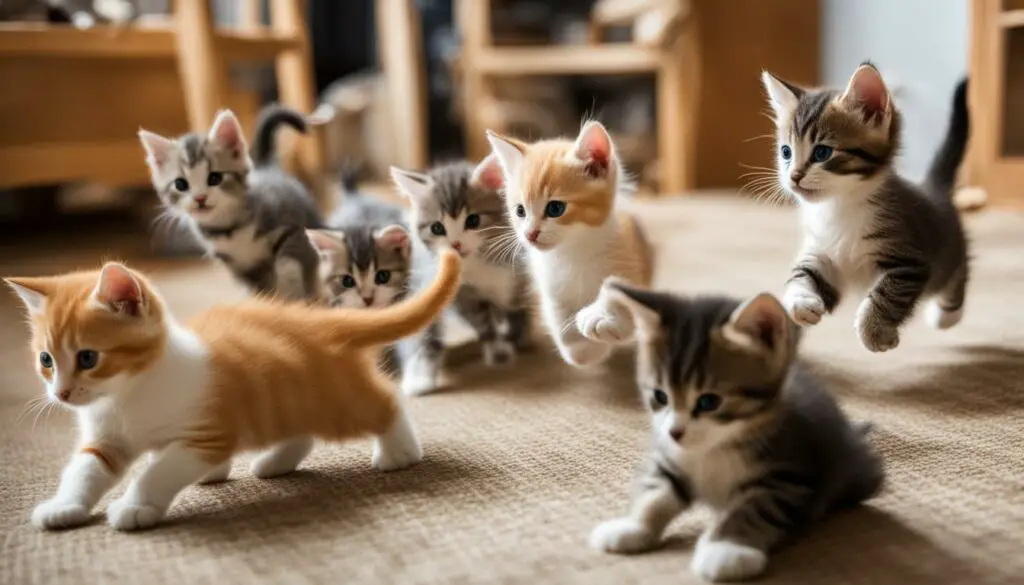Adding a new kitten to the family is an exciting experience. However, some kittens may exhibit excessive energy and hyperactivity, which can be indicative of a condition known as hyperactive kitten syndrome. In this article, I will delve into the characteristics of hyperactive kittens, provide tips on how to calm them down, and offer guidance on managing their behavior.
Key Takeaways:
- Hyperactive kitten syndrome can be characterized by excessive energy and behaviors that go beyond typical kitten playfulness.
- It is important to visit a veterinarian to rule out any underlying health issues contributing to hyperactivity.
- Regular play sessions tailored to satisfy their hunting instincts can help reduce hyperactivity.
- Creating a cat-friendly environment and establishing a consistent routine are essential for managing hyperactive kittens.
- Adopting two kittens instead of one can provide companionship and help reduce hyperactive behaviors.
What Does a Hyperactive Kitten Look Like?
Hyperactive kittens exhibit behaviors that go beyond the typical high energy levels seen in normal kittens. It is important to identify these behaviors in order to determine if your kitten may have hyperactive kitten syndrome. Some common signs of hyperactivity in kittens include:
- Failing to tire out after play
- Engaging in destructive behaviors
- Darting around the home (“zoomies”)
- Attention-seeking behavior
- Potential conflicts with other cats
If you notice these behaviors in your kitten, it is important to consult with a veterinarian to rule out any underlying health issues. Identifying hyperactivity early on can help you provide the necessary care and guidance to manage your kitten’s behavior.
Remember, not all high-energy kittens have hyperactive kitten syndrome. It is essential to observe your kitten’s behavior over time and seek professional advice to accurately diagnose and address their needs.
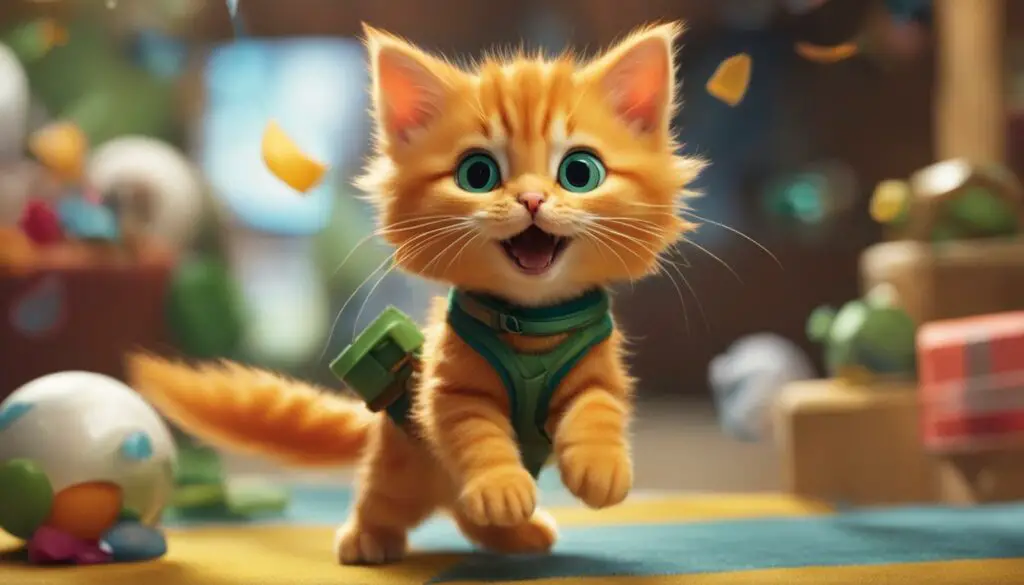
Identifying Hyperactive Kittens
When trying to identify hyperactive kittens, look for persistent and extreme behaviors that disrupt their daily routine. These may include excessive running and jumping, constant demands for attention, and difficulty settling down. Hyperactive kittens may also show signs of impulsivity, such as pouncing without warning or engaging in rough play with humans or other pets. It is important to differentiate between normal kitten behavior and hyperactivity in order to provide appropriate care and support.
| Behavior | Normal Kitten Behavior | Hyperactive Kitten Behavior |
|---|---|---|
| High energy levels | Yes | Excessive and persistent |
| Playfulness | Yes | Intense and constant |
| Attention-seeking | Occasional | Constant and demanding |
| Destructive behavior | No | Yes |
| Aggressive play | No | Potential for rough play |
By understanding the signs of hyperactivity in kittens, you can take appropriate steps to manage their behavior and create a harmonious living environment for both you and your feline friend.
How To Calm Down a Kitten
Calming down a hyperactive kitten requires employing specific strategies. First, it is essential to visit a veterinarian to rule out any potential underlying health issues contributing to their hyperactivity. Following that, conducting a behavior audit to identify triggers and patterns can provide insights into managing their energy levels. Additionally, engaging in regular play sessions tailored to satisfy their hunting instincts can help reduce hyperactivity.
Techniques to Relax Kittens
When it comes to calming hyperactive kittens, there are several techniques that can be effective. Creating a calm and quiet environment can help alleviate their anxiety and promote relaxation. This can be achieved by providing a designated resting area away from distractions and loud noises. Additionally, incorporating gentle stroking and soothing voices can provide comfort and security.
Another technique to relax kittens is through the use of pheromone diffusers, such as Feliway®. These diffusers release synthetic pheromones that mimic the natural pheromones produced by mother cats, helping to create a sense of familiarity and calmness in the environment. Placing a diffuser in the area where the kitten spends most of their time can have a calming effect.
Reducing Kitten Hyperactivity
In addition to the above techniques, there are other strategies that can help reduce kitten hyperactivity. Engaging in interactive play sessions with appropriate toys can help channel their excess energy and provide mental stimulation. It is important to use toys that encourage active play, such as wand toys or puzzle toys that dispense treats.
Establishing a consistent routine for feeding, playtime, and rest can also help regulate their energy levels. Kittens thrive on predictability, and having a structured schedule can provide them with a sense of security and stability. Finally, providing plenty of hiding spots and vertical space, such as cat trees or shelves, can give them opportunities to retreat and relax when they need a break.
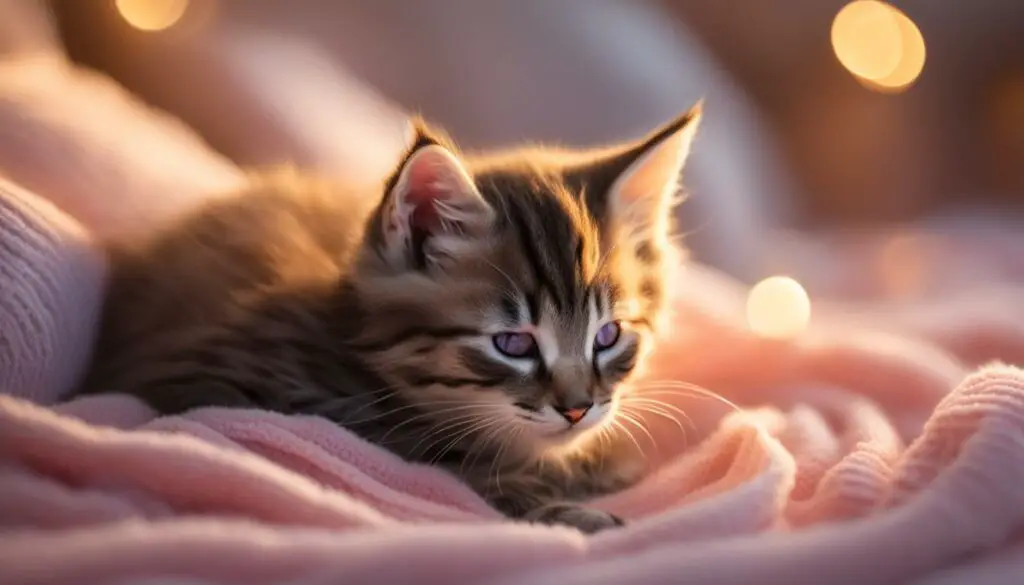
Table: Techniques for Calming Hyperactive Kittens
| Technique | Description |
|---|---|
| Create a calm environment | Provide a quiet resting area and minimize loud noises. |
| Use pheromone diffusers | Distribute synthetic pheromones to promote relaxation. |
| Engage in interactive play | Use appropriate toys to provide physical and mental stimulation. |
| Establish a consistent routine | Provide structure and predictability in daily activities. |
| Offer hiding spots and vertical space | Provide areas for the kitten to retreat and feel safe. |
Tips for Playing with a Hyperactive Kitten
Playing with a hyperactive kitten is an important part of managing their excessive energy levels. By engaging in interactive play sessions, you can provide a healthy outlet for their energy and help them burn off excess energy. Here are some tips to make playtime with your hyperactive kitten enjoyable and beneficial:
- Choose interactive toys: Opt for toys that stimulate their hunting instincts, such as wand toys, feathered toys, or laser pointers. These toys will keep your hyperactive kitten engaged and provide mental and physical stimulation.
- Vary playtime activities: Incorporate a mix of chasing, pouncing, and jumping activities during play sessions. This variety will prevent your kitten from becoming bored and maintain their interest in playtime.
- Set a playtime routine: Establish a regular playtime schedule and stick to it. Having consistent play sessions will help your hyperactive kitten release their energy in a structured manner.
- Keep play sessions short but frequent: Hyperactive kittens can tire easily, so it’s best to have multiple short play sessions throughout the day. Aim for play sessions that last 10 to 15 minutes each.
Remember, playing with your hyperactive kitten should be a fun and positive experience. Use these tips to create an engaging playtime routine that will help manage their energy levels and strengthen the bond between you and your furry friend.
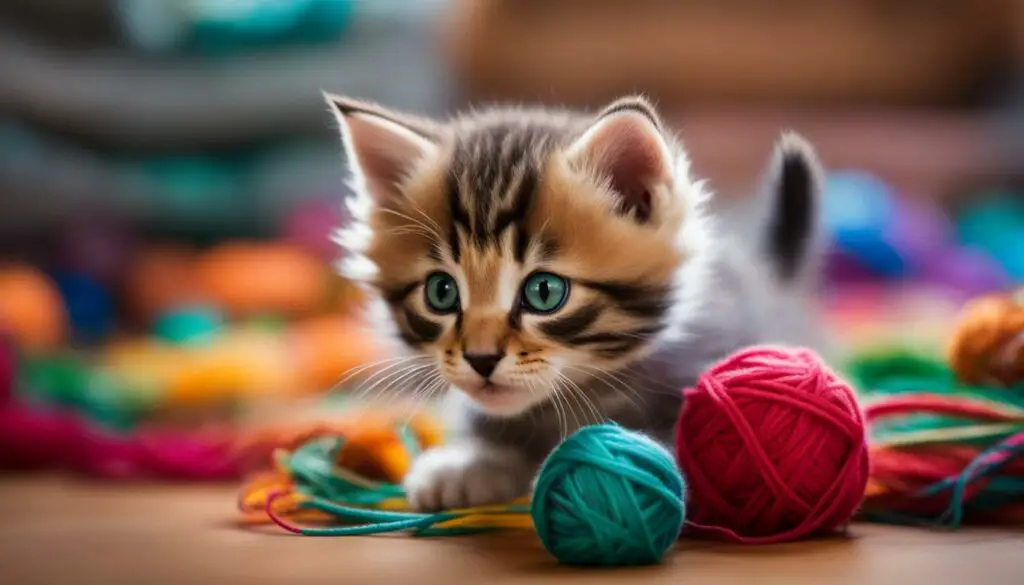
Toys for Interactive Play
| Toy | Description |
|---|---|
| Wand toy | A long stick with feathers or a dangling object at the end. It allows you to mimic prey movement and engage your hyperactive kitten in active play. |
| Laser pointer | A handheld device that emits a laser beam. Move the laser around for your kitten to chase, but avoid shining it directly into their eyes. |
| Feathered toy | A small toy with feathers attached to a string or stick. Cats are naturally attracted to the movement of feathers, making this toy a great option for interactive play. |
| Balls with bells | Small balls with bells inside that make noise when rolled or swatted. These toys encourage your hyperactive kitten to chase and bat at them. |
Having a selection of interactive toys will keep playtime exciting and engaging for your hyperactive kitten. Monitor their play sessions to ensure they are playing safely and supervise them while using toys like laser pointers to prevent accidental eye injuries.
Why Is My Kitten So Hyper?
Understanding the reasons behind your kitten’s hyperactivity can help you better manage their behavior and ensure their well-being. Several factors contribute to a kitten’s excessive energy and hyperactive behavior.
Kitten’s Normal Behavior and Brain Development
It is important to remember that kittens naturally have high energy levels. They are inquisitive and curious creatures, constantly exploring their surroundings. This instinctual behavior, coupled with their developing brain, can contribute to hyperactivity. As their brains are not fully matured, kittens may struggle to regulate their energy levels and exhibit bursts of hyperactive behavior.
Genetic Predisposition to Hyperactivity
Certain cat breeds may have a genetic predisposition to hyperactivity. For example, Bengal cats are known for their high energy levels and need for stimulation. If your kitten belongs to a breed with a higher likelihood of hyperactivity, it is essential to provide ample outlets for their energy and mental stimulation.
Quote: “It is important to remember that kittens naturally have high energy levels. They are inquisitive and curious creatures, constantly exploring their surroundings.”
Environmental Factors and Lack of Stimulation
The environment in which your kitten grows up can also influence their energy levels. A lack of playtime and mental stimulation can lead to pent-up energy, resulting in hyperactive behavior. It is crucial to provide your kitten with interactive toys, scratching posts, and engaging activities to keep them mentally and physically stimulated.
| Causes of Hyperactivity in Kittens |
|---|
| Normal kitten behavior and brain development |
| Genetic predisposition to hyperactivity |
| Environmental factors and lack of stimulation |
Understanding the underlying causes of your kitten’s hyperactivity can help you tailor your approach to managing their energy levels. By providing a stimulating environment, engaging in regular playtime, and addressing any breed-specific needs, you can create a calmer and more balanced environment for your hyperactive kitten.
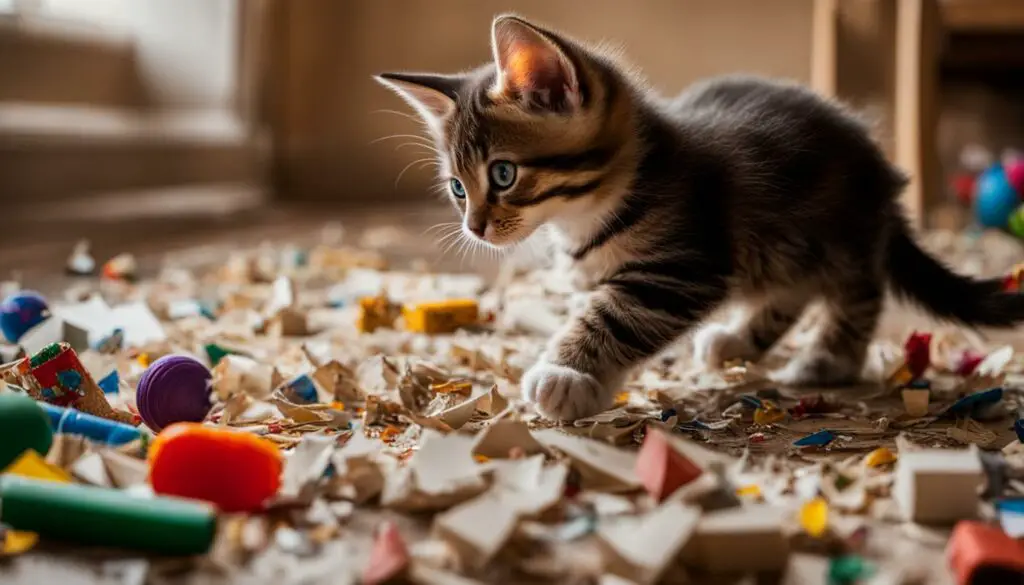
How To Prepare for a Hyperactive Kitten
If you’re considering bringing a hyperactive kitten into your home, it’s important to be prepared for the extra attention and care they’ll require. Managing hyperactivity in new kittens involves creating a cat-friendly environment, understanding their needs, and providing them with the right resources. Here are some essential kitten care tips to help you prepare:
Creating a Cat-Friendly Environment
Before bringing your hyperactive kitten home, it’s crucial to cat-proof your living space. Remove any small objects that could be hazardous if ingested, secure loose wires or cords, and ensure there are no potential escape routes. Additionally, invest in scratching posts, cat trees, and interactive toys to provide outlets for their energy. Designate a quiet, safe space where your kitten can retreat to when feeling overwhelmed or tired.
Understanding their Needs
Hyperactive kittens require ample mental and physical stimulation to help manage their energy levels. They thrive on playtime, interaction, and exploration. Set aside dedicated play sessions throughout the day to engage their hunting instincts and tire them out. Interactive toys, food puzzles, and clicker training can provide mental stimulation and redirect their energy in a positive way. Remember to also provide cozy resting spots and plenty of cuddle time to create a sense of security and comfort.
Consistency and Patience
Managing hyperactivity in kittens requires consistency and patience. Establish a routine for feeding, playtime, and rest to create a sense of stability for your hyperactive kitten. Stick to the same schedule every day to help them feel secure and reduce anxiety-induced hyperactivity. Use positive reinforcement techniques to reward good behavior and redirect unwanted behaviors with gentle correction. Remember that it may take time for your kitten to adjust to their new environment, so be patient and understanding during the process.
By preparing yourself and your home for a hyperactive kitten, you can create an environment that promotes their well-being and helps manage their energy levels. Remember to provide mental and physical stimulation, establish a consistent routine, and offer plenty of love and attention. With the right care and attention, you can ensure a harmonious and fulfilling relationship with your hyperactive feline friend.
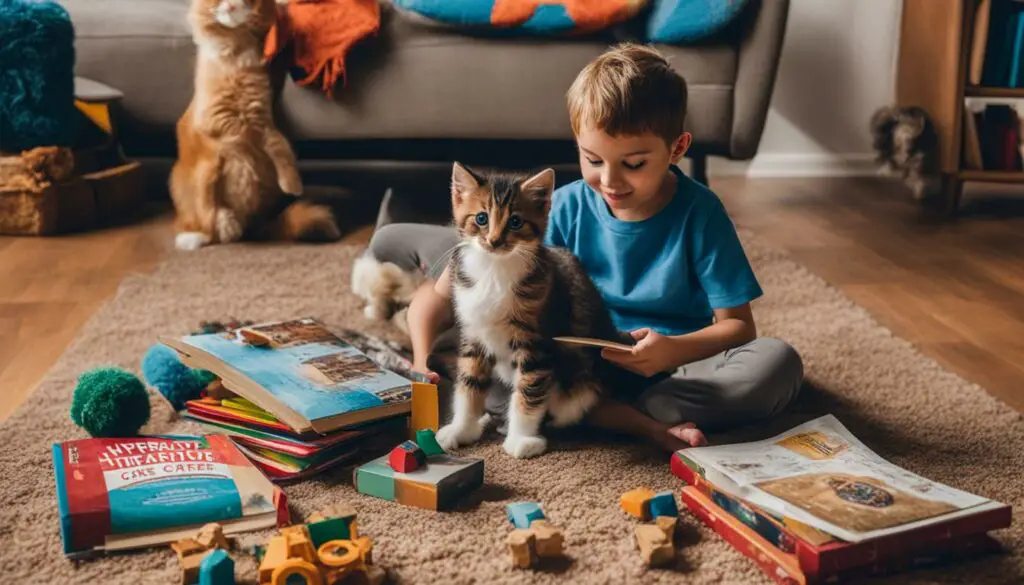
Cat-Proofing Your Home for a Hyperactive Kitten
When you have a hyperactive kitten, it’s essential to create a safe and enriched environment that supports their boundless energy. Cat-proofing your home is crucial to prevent accidents and keep your kitten out of harm’s way. Here are some tips to help you provide a secure and stimulating space for your hyperactive furball:
1. Remove Potential Hazards
Take the time to carefully inspect your home and remove any small objects that could pose a choking hazard to your curious kitten. Keep toxic plants out of their reach, secure loose cables, and ensure that cleaning products and medications are stored in cabinets that your kitten cannot access. By eliminating potential dangers, you can minimize the risk of accidents and promote a safe environment for your hyperactive kitten.
2. Create Safe Spaces
Hyperactive kittens often need a place to retreat and recharge. Provide hiding spots or cozy areas where they can feel safe and secure. Consider getting a cat tree or providing elevated perches and shelves for them to climb and explore. These vertical spaces not only give your kitten an outlet for their energy but also provide them with a sense of security and territory.
3. Offer Enrichment Activities
Hyperactive kittens thrive on mental stimulation and interactive play. Provide a variety of toys that engage their hunting instincts, such as puzzle toys and treat dispensers. Rotate their toys regularly to keep them interested and prevent boredom. Additionally, consider using interactive feeders to make mealtime more engaging and enriching for your hyperactive kitten.
| Toy Type | Description |
|---|---|
| Interactive Wand Toys | These toys simulate prey and allow your hyperactive kitten to engage in interactive play with you. They help satisfy their hunting instincts and provide an outlet for their energy. |
| Feathered Toys | Feathered toys mimic the movement of birds and are highly stimulating for hyperactive kittens. They encourage pouncing, chasing, and leaping, allowing your kitten to burn off excess energy. |
| Puzzle Toys | Puzzle toys challenge your hyperactive kitten’s problem-solving skills while providing mental stimulation. These toys often require your kitten to figure out how to retrieve treats or toys hidden inside. |
By implementing these cat-proofing measures and offering enrichment activities, you can provide a safe and engaging environment that supports your hyperactive kitten’s needs. Remember to supervise your kitten during playtime and provide them with plenty of love, attention, and positive reinforcement. With patience and understanding, you can help your hyperactive kitten thrive and create a harmonious home environment.
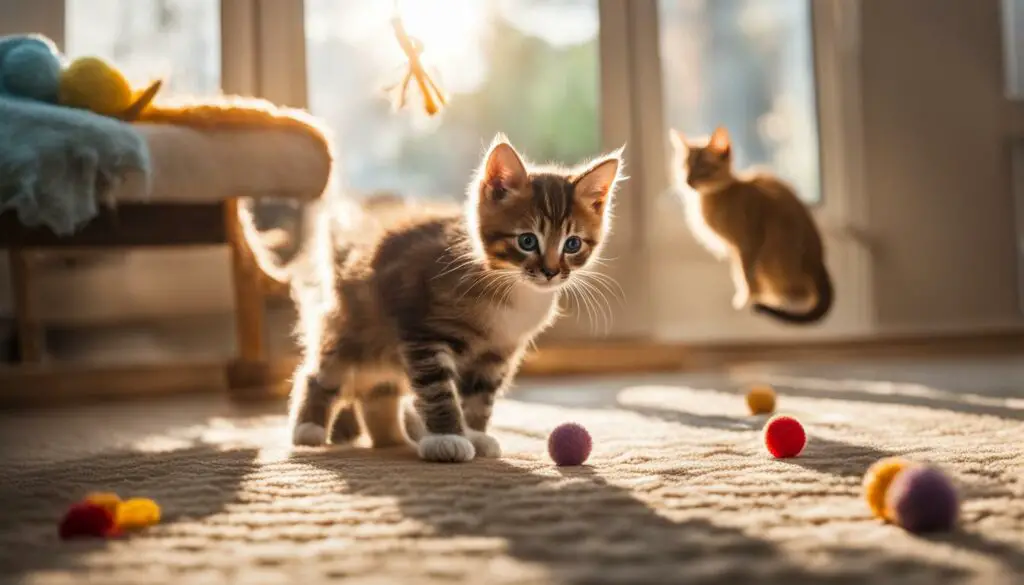
The Importance of Consistent Routine
Establishing a consistent routine for hyperactive kittens is vital for managing their energy levels and promoting their overall well-being. By following a regular schedule, you can provide a sense of stability and predictability that helps cats feel secure and minimizes anxiety-induced hyperactivity.
Consistency in kitten care involves several key aspects, including feeding, playtime, and rest periods. By adhering to set meal times, you can regulate your kitten’s energy levels and ensure they receive the necessary nutrition. It is recommended to feed them at the same times each day, using high-quality kitten food that meets their specific dietary needs.
Playtime also plays a crucial role in managing hyperactivity. Regular, structured play sessions using interactive toys can help kittens expend their energy in a productive and engaging manner. Aim for multiple short play sessions throughout the day, each lasting around 10 to 15 minutes. This approach emulates a cat’s natural hunting instincts, keeping them mentally stimulated and physically active.
Benefits of a regular schedule for hyperactive kittens
- Reduces anxiety: A consistent routine provides a sense of security for hyperactive kittens, helping to minimize feelings of stress and anxiety.
- Channelizes energy: By following a regular schedule that includes designated playtimes, you can help kittens burn off excess energy in a controlled manner, reducing hyperactivity.
- Promotes good behavior: A consistent routine reinforces positive behaviors and helps teach kittens appropriate boundaries, leading to better overall behavior and reduced hyperactive tendencies.
- Supports healthy development: Kittens thrive on structure and routine, and a regular schedule can contribute to their overall growth and development.
- Enhances bonding: The predictability and consistency of a routine allow for increased interaction and bonding between you and your hyperactive kitten.
By establishing and maintaining a consistent routine, you can effectively manage hyperactivity in kittens and create a harmonious living environment for both you and your feline companion.
The Role of Mental Stimulation
Mental stimulation plays a crucial role in managing hyperactivity in kittens. Engaging their minds through various activities can help prevent boredom and redirect their energy in positive ways. Here are some effective strategies to provide mental stimulation for hyperactive kittens:
- Create puzzle toys: Puzzle toys are a great way to challenge and engage a hyperactive kitten’s mind. These toys have hidden treats or compartments that require problem-solving skills to access the rewards. This not only keeps them mentally stimulated but also provides a sense of accomplishment.
- Offer interactive playtime: Interactive play sessions using feather wands or laser pointers can stimulate a hyperactive kitten’s natural hunting instincts. Moving the toy in unpredictable ways and encouraging them to chase and pounce can provide mental and physical exercise.
- Introduce clicker training: Clicker training is a positive reinforcement technique that involves associating a clicking sound with a reward. By teaching your hyperactive kitten simple tricks or commands, you can provide mental stimulation and reinforce desired behaviors.
- Rotate toys: Hyperactive kittens can quickly become bored with the same toys. To maintain their interest, rotate their toys regularly, introducing new ones and keeping the old ones stored away for a while. This novelty will keep them engaged and prevent boredom.
By incorporating these mental stimulation techniques into your hyperactive kitten’s daily routine, you can help keep their minds busy and provide outlets for their energy, reducing unwanted hyperactive behaviors.
“Mental stimulation is crucial for hyperactive kittens. Providing puzzle toys, hiding treats, and incorporating clicker training can engage their minds and provide outlets for their energy. These activities can also help prevent boredom, which can contribute to hyperactive behavior.”
Remember, every kitten is unique, so it’s essential to observe your hyperactive kitten’s preferences and adjust the mental stimulation activities accordingly. It’s always a good idea to consult with a veterinarian or a professional cat behaviorist for personalized guidance based on your kitten’s specific needs.
| Mental Stimulation Techniques | Benefits |
|---|---|
| Create puzzle toys | Challenges their problem-solving skills and provides a sense of accomplishment. |
| Offer interactive playtime | Engages their natural hunting instincts and provides mental and physical exercise. |
| Introduce clicker training | Provides mental stimulation and reinforces desired behaviors through positive reinforcement. |
| Rotate toys | Keeps their interest and prevents boredom by introducing new toys. |
By implementing these techniques and tailoring them to your hyperactive kitten’s preferences, you can keep their minds engaged and provide a stimulating environment that promotes their overall well-being.
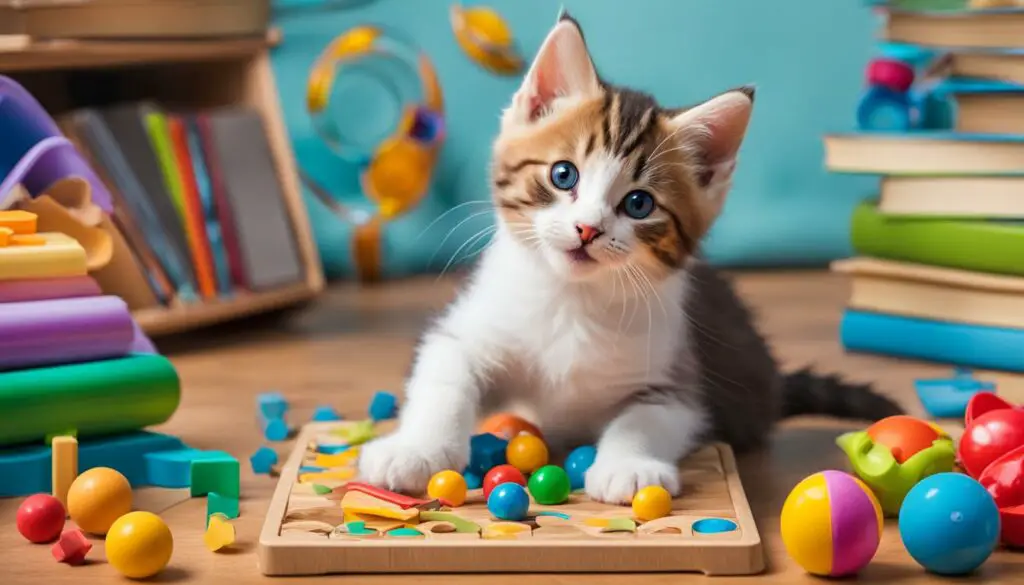
Creating a Calm Environment
When it comes to managing hyperactivity in kittens, creating a calm environment can play a significant role. There are several techniques you can employ to help soothe your hyperactive kitten and create a peaceful atmosphere at home.
Playing Soothing Music
One effective method is to play soothing music specifically designed for cats. The calming melodies and frequencies can help create a tranquil ambiance that can help relax your kitten. You can find specially curated playlists or albums online that are designed to reduce stress and anxiety in cats. This can be particularly useful during times when your kitten tends to become more hyperactive, such as in the evenings or before bedtime.
Introducing Valerian Root
Another option to consider is using valerian root, a natural herb known for its calming properties. Valerian root can be found in various forms, such as sprays, treats, or as an ingredient in toys. When exposed to the scent of valerian root, many cats experience a sense of relaxation and tranquility. However, it’s important to note that some cats may have a strong reaction to valerian root, so it’s best to introduce it gradually and observe how your kitten responds.
| Pros of Creating a Calm Environment | Cons of Creating a Calm Environment |
|---|---|
| – Helps reduce stress and anxiety in kittens – Creates a peaceful and relaxing atmosphere – Promotes better sleep and rest – Enhances overall well-being |
– Some kittens may not respond to calming techniques – The scent of valerian root may be overpowering for some cats – It may take time to find the right combination of methods that work for your kitten |
By implementing these techniques and creating a calm environment, you can help manage your hyperactive kitten’s energy levels and promote a sense of relaxation. Remember to be patient and observe how your kitten responds to different methods, adjusting as necessary to find the best approach for your furry friend.

Considering Adopting Two Kittens
If you’re thinking about bringing a kitten into your home, you may want to consider adopting two instead of one. Adopting multiple kittens can have several benefits, including reducing hyperactivity through companionship.
When you adopt two kittens, they can tire each other out through play and provide constant companionship. This can help reduce the intensity of their hyperactive behaviors and prevent them from constantly seeking attention from you. Kittens learn a lot from each other, including appropriate play and social skills, so having a feline playmate can be highly beneficial for their development.
Additionally, adopting two kittens gives them the opportunity to form a bond and build a strong sibling relationship. They will have a companion to snuggle with, groom, and rely on for comfort. This can help alleviate any separation anxiety they may experience when you’re not around.
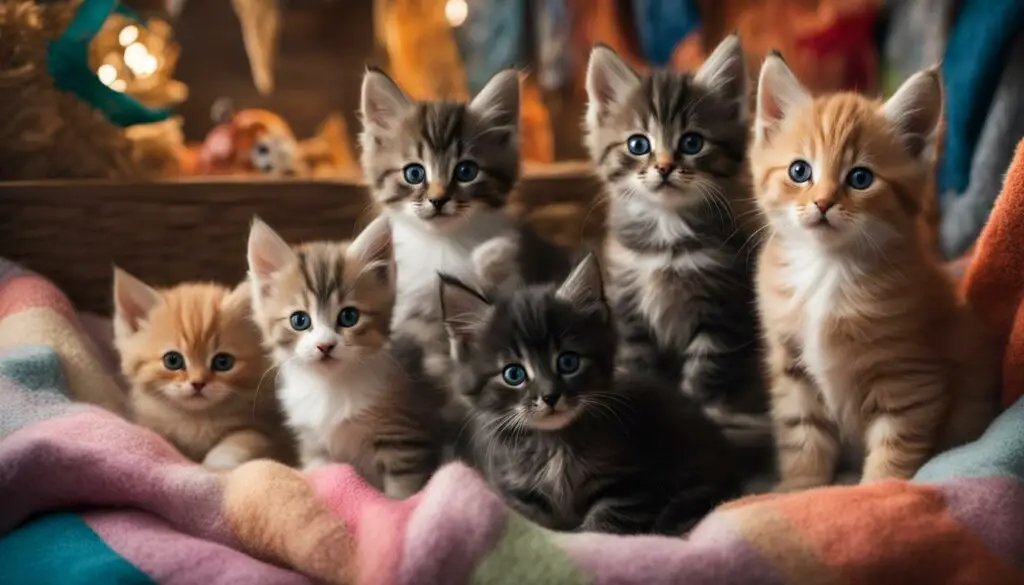
However, it is important to remember that adopting two kittens means double the responsibility. You will need to provide enough space, resources, and attention for both kittens to thrive. Ensure you have enough litter boxes, food and water bowls, scratching posts, and toys to accommodate two kittens. It is also essential to schedule regular playtime sessions with both kittens to keep them mentally stimulated and physically active.
By adopting two kittens instead of one, you not only provide a loving home for multiple feline friends, but you also create a harmonious environment and reduce the hyperactivity commonly associated with single kittens. The companionship and bond between the kittens will bring joy and entertainment to your home while ensuring their well-being.
The Transition to Adulthood
As kittens grow, they go through distinct stages of development before reaching adulthood. Understanding these stages can help us navigate their changing behaviors and expectations. Here’s a breakdown of the kitten development stages:
1. Neonatal Stage (0-2 weeks)
In the neonatal stage, kittens are completely dependent on their mother for survival. They spend most of their time sleeping and feeding. Their eyes and ears are closed, and they rely on touch and smell to navigate their environment. During this stage, it’s crucial to provide a warm and quiet space for the mother and her kittens.
2. Transitional Stage (2-4 weeks)
In the transitional stage, kittens start to open their eyes and ears, allowing them to explore their surroundings more actively. They begin to walk and play with their littermates, developing essential social and motor skills. Introducing gentle human interaction during this stage is important to foster positive experiences and build trust.
3. Socialization Stage (4-14 weeks)
The socialization stage is a critical period for kittens, as they learn to interact with humans and other animals. They become more curious and adventurous, exploring new environments and experiencing various stimuli. Proper socialization during this stage sets the foundation for their future behavior and adaptability.
4. Adolescence (14 weeks to 1 year)
During adolescence, kittens go through a period of rapid growth and hormonal changes. They may become more independent, testing boundaries and asserting their individuality. It’s common for kittens to exhibit bursts of energy and engage in rough play during this stage. Consistent guidance and positive reinforcement are key to managing their behavior.
5. Adulthood (1 year and older)
By the time kittens reach adulthood, typically around 1 to 2 years of age, they have usually calmed down significantly. While individual personalities and energy levels may vary, most cats have settled into a more relaxed and balanced state. Providing regular exercise, mental stimulation, and a stable environment can help maintain their well-being as they transition into adult cats.
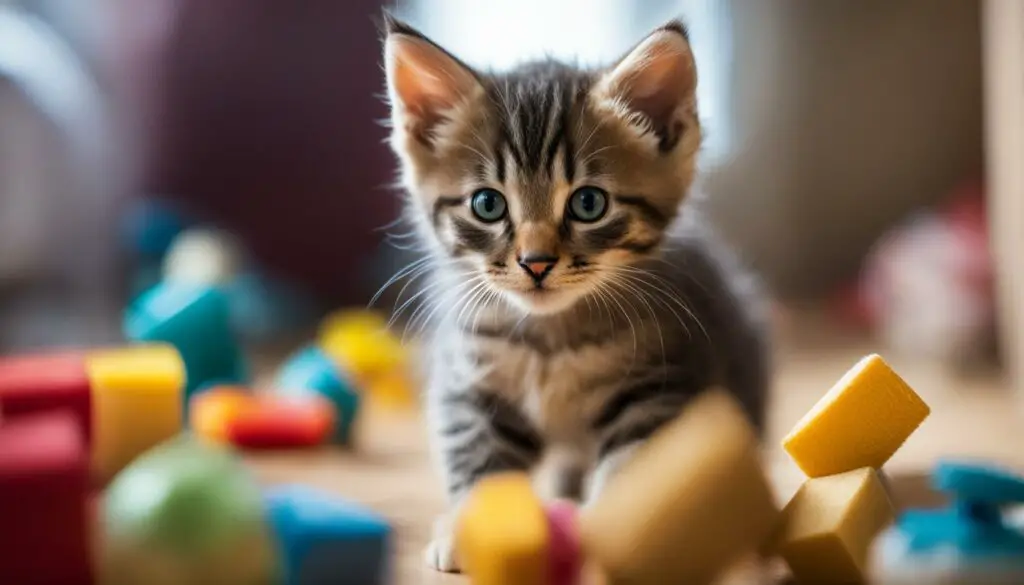
Understanding the different stages of kitten development allows us to adjust our expectations and provide the appropriate care and guidance throughout their journey to adulthood. By being patient, consistent, and attentive to their changing needs, we can help our kittens grow into happy, well-adjusted adult cats.
Managing Hyperactivity in Older Cats
As cats age, they may continue to exhibit hyperactive behavior. While hyperactivity is often associated with kittens, it is important to provide appropriate behavioral management for older cats as well. By maintaining both mental and physical stimulation, you can help channel their energy in positive ways.
Behavioral Management: Older cats may benefit from a consistent routine and structured playtime. Set aside specific times each day for interactive play sessions using toys that encourage exercise and mental engagement. This can help satisfy their hunting instincts and provide a healthy outlet for their energy.
Environmental Enrichment: Creating a stimulating environment is essential for older cats with hyperactivity. Provide scratching posts, climbing trees, and interactive toys to keep them physically and mentally engaged. Consider adding puzzle toys or treat-dispensing toys to provide mental stimulation and help alleviate boredom.
Regular Vet Check-ups: It is important to schedule regular check-ups with your veterinarian to rule out any underlying medical conditions that may contribute to hyperactivity. They can also provide guidance on managing your cat’s energy levels and offer recommendations for appropriate behavioral interventions.
| Benefits of Managing Hyperactivity in Older Cats | Methods |
|---|---|
| Improved overall well-being | Consistent playtime and mental stimulation |
| Reduced destructive behavior | Creating a stimulating environment |
| Eased anxiety and stress | Regular vet check-ups |
By implementing these strategies, you can help manage hyperactivity in older cats and provide them with a happy and fulfilling life. Remember that each cat is unique, so it may take time and experimentation to find the right combination of techniques that work best for your furry friend.
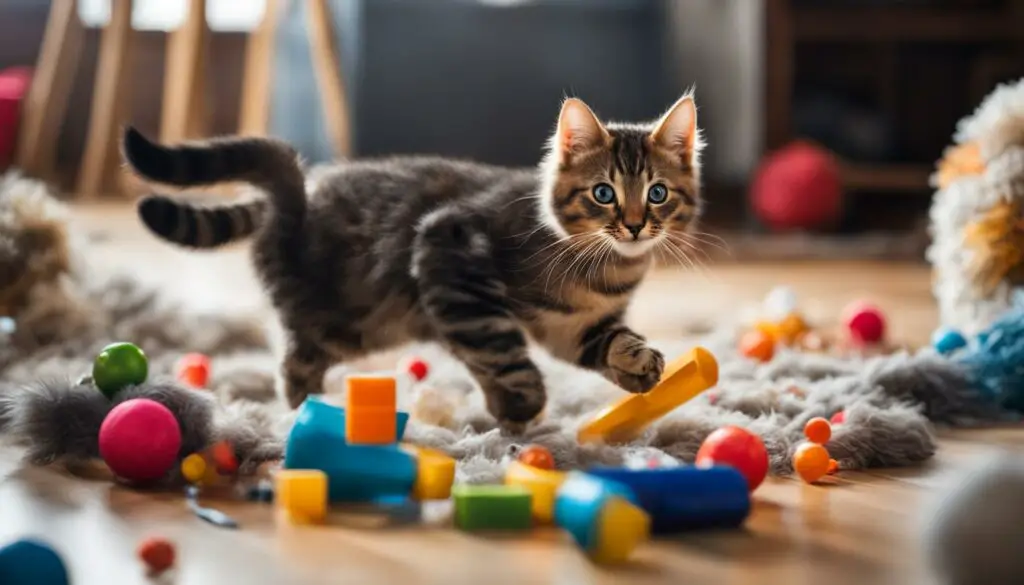
Tips for a Happy, Harmonious Home
Managing cat behavior problems and promoting harmony among pets are essential for maintaining a positive home environment. Here are some tips to help you create a happy and peaceful atmosphere:
1. Establish Clear Boundaries
Setting boundaries is crucial for maintaining harmonious relationships between pets. Provide designated spaces for each cat, such as separate feeding areas, litter boxes, and resting spots. This will help prevent territorial conflicts and create a sense of personal space for each pet.
2. Provide Enrichment Activities
Engaging your cats in stimulating activities is an effective way to redirect their energy and prevent behavior problems. Set up interactive toys, scratching posts, and puzzle feeders to keep them mentally and physically stimulated. Regular play sessions with appropriate toys can also help reduce hyperactivity and promote bonding between you and your cats.
3. Practice Positive Reinforcement
Promote desired behaviors by rewarding your cats for good behavior. Use treats, praise, and affection to reinforce positive actions such as using the litter box, using scratching posts, and peacefully interacting with other pets. Positive reinforcement helps create a positive association and encourages your cats to repeat desirable behaviors.
By implementing these tips, you can create a harmonious environment where your cats can thrive and enjoy a happy and fulfilling life. Remember, patience and consistency are key to managing cat behavior problems and maintaining a positive home for everyone.
| Tips for a Happy, Harmonious Home |
|---|
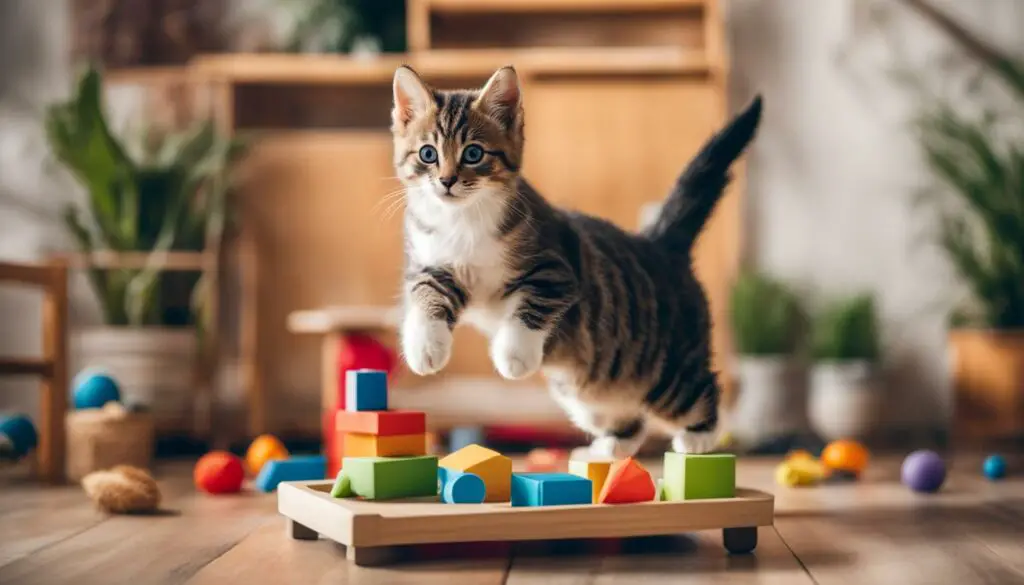 |
|
Conclusion
Understanding hyperactive kitten syndrome and managing hyperactivity in cats is key to fostering a happy and harmonious relationship with your feline companion. By implementing the following hyperactive kitten care tips, you can create a balanced and enjoyable environment for your energetic little friend:
Firstly, it is important to understand kitten behavior. Recognizing the signs of hyperactivity and differentiating them from normal kitten behavior is crucial. By identifying these behaviors, you can take appropriate steps to manage and provide the necessary care.
Secondly, managing hyperactivity in cats requires a multi-faceted approach. This includes providing ample playtime, mental stimulation, and environmental enrichment. Engaging your kitten with interactive toys, puzzle feeders, and regular play sessions not only helps channel their energy but also stimulates their minds, preventing boredom and potential destructive behaviors.
Lastly, consistency and patience are key. Establishing a routine, providing a calm and cat-friendly environment, and addressing any conflicts or behavioral issues in a positive manner all contribute to managing hyperactivity in cats effectively.
With these hyperactive kitten care tips and a deep understanding of your feline companion’s needs, you can create a loving and harmonious home that nurtures their energy while also ensuring their well-being.
FAQ
What are the signs of hyperactivity in kittens?
Signs of hyperactivity in kittens may include failing to tire out after play, engaging in destructive behaviors, darting around the home (“zoomies”), attention-seeking behavior, and potential conflicts with other cats.
How can I calm down a hyperactive kitten?
Calming down a hyperactive kitten can be achieved by visiting a veterinarian to rule out any underlying health issues, conducting a behavior audit to identify triggers and patterns, engaging in regular play sessions, and providing mental stimulation.
What are some tips for playing with a hyperactive kitten?
To play with a hyperactive kitten, use interactive toys like wands and feathered toys to engage their hunting instincts. Have multiple short play sessions throughout the day, lasting 10 to 15 minutes each. Food puzzles and clicker training can also be effective in stimulating their minds and redirecting their energy.
Why is my kitten so hyper?
Hyperactivity in kittens can be attributed to their natural curiosity, developmental stage, and instinctual behaviors. Factors such as brain development, genetic predisposition, lack of playtime, mental stimulation, and unintentional reinforcement of hyperactive behaviors can also contribute to excessive energy in kittens.
How can I prepare for a hyperactive kitten?
To prepare for a hyperactive kitten, create a cat-friendly environment with scratching posts, cat trees, and engaging toys. Understand that kittens need daily interaction and playtime, and be mentally prepared for the extra attention they require.
How can I provide a safe and enriched environment for my hyperactive kitten?
To provide a safe and enriched environment for your hyperactive kitten, block off areas where they may get stuck, remove small objects that could be hazards, and offer scratching posts and cat trees. Providing a window perch and interactive toys can also keep them mentally stimulated and alleviate boredom.
What is the importance of a consistent routine for hyperactive kittens?
A consistent routine for hyperactive kittens can help manage their energy levels. Feeding, playtime, and rest periods should be at regular intervals to create a sense of stability and predictability, reducing anxiety-induced hyperactivity.
How can I provide mental stimulation for my hyperactive kitten?
Providing puzzle toys, hiding treats, and incorporating clicker training can engage your hyperactive kitten’s mind and provide outlets for their energy. These activities can also help prevent boredom, which can contribute to hyperactive behavior.
What can I do to create a calm environment for my hyperactive kitten?
To create a calm environment for your hyperactive kitten, you can play soothing music, provide cozy resting spots, and use calming herbs such as valerian root. Additionally, giving them plenty of attention and cuddle time can provide comfort and reassurance.
Should I consider adopting two kittens instead of one?
Adopting two kittens instead of one can be beneficial in managing hyperactivity. Kittens can tire each other out through play and provide companionship, reducing the intensity of their hyperactive behaviors. They can learn appropriate play and social skills from each other, alleviating the need for constant human interaction.
What can I expect during the transition to adulthood for my hyperactive kitten?
As kittens grow, they gradually transition from the hyperactive phase to adolescence and eventually adulthood. Around 1 year of age, kittens start to calm down, although they may still have bursts of energy during their adolescent phase. By 2 years of age, most cats have reached a more settled state.
How can I manage hyperactivity in older cats?
To manage hyperactivity in older cats, provide ample playtime, mental stimulation, and environmental enrichment. Regular vet check-ups are important to rule out any underlying medical conditions contributing to hyperactivity.
What are some tips for promoting a happy and harmonious home with a hyperactive cat?
To promote a happy and harmonious home with a hyperactive cat, understand their behavior, provide consistent guidance and positive reinforcement, and offer appropriate outlets for their energy. Creating a loving and calm environment, maintaining a routine, and addressing any conflicts between cats can help manage hyperactivity and foster a peaceful coexistence.
How can I understand hyperactive kitten syndrome and effectively manage it?
Understanding hyperactive kitten syndrome and implementing effective management strategies involves creating the right environment, providing regular playtime and mental stimulation, and providing consistent care. By doing so, pet owners can navigate the challenges of hyperactive kittens and ensure a happy and healthy life for their feline companions.
Source Links
- https://be.chewy.com/ways-to-calm-a-hyper-kitten/
- https://www.tuxedo-cat.co.uk/hyperactive-kitten-syndrome/
- https://petmd.com/cat/behavior/my-kitten-too-hyper

